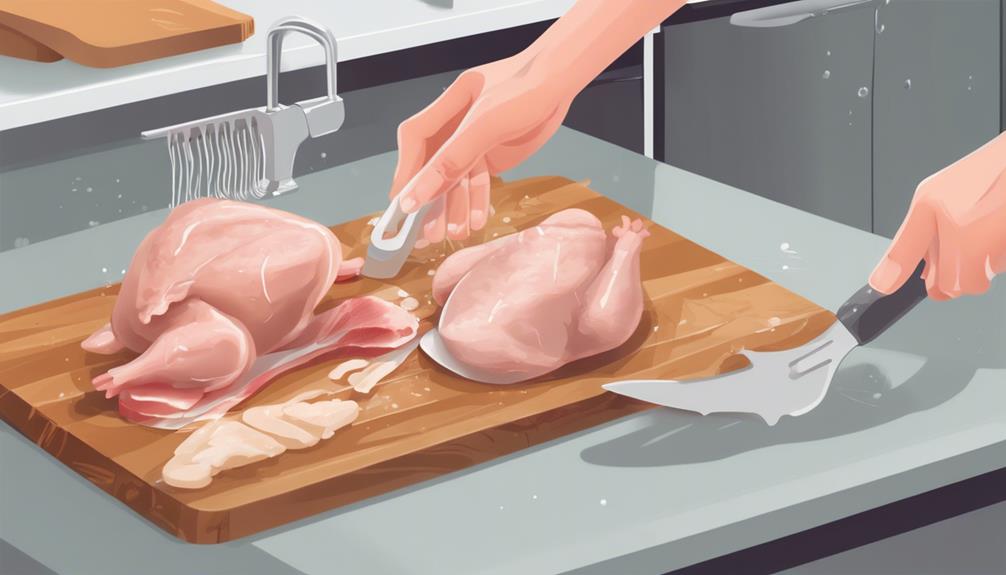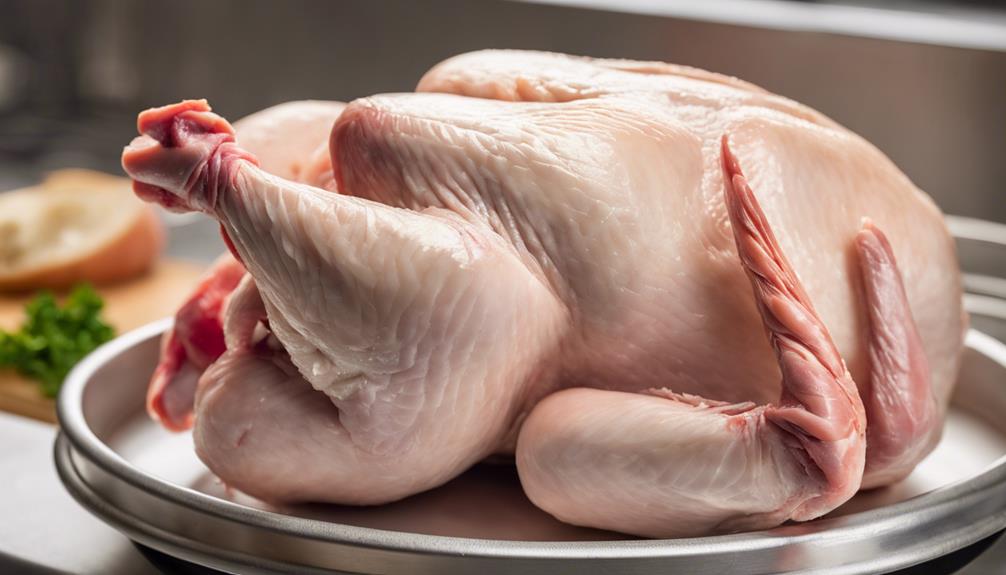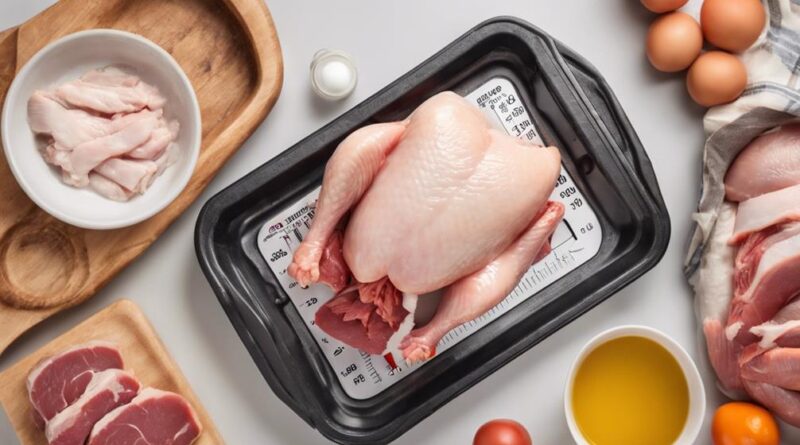10 Best Ways Raw Chicken Influences Food Safety
When handling raw chicken, remember to follow key safety practices: Thaw using fridge, cold water, or microwave to deter bacteria. Store in leak-proof containers in the fridge, segregate cutting boards for raw meat, and wash hands often. Keep chicken below 40°F (4°C) or freeze at 0°F (-18°C) in sealed bags. Cook thoroughly to 165°F (73.9°C) using a thermometer to avoid undercooking risks. Maintain a clean kitchen, sanitize surfaces, and store chicken separately. Understanding these methods prevents foodborne illnesses and ensures safe consumption.
Bacterial Contamination Risks
How does raw chicken contribute to the risks of bacterial contamination in food preparation? Raw chicken poses significant risks of bacterial contamination due to improper handling. When thawing raw chicken, it's crucial to follow proper thawing techniques to prevent bacterial growth. Thawing should ideally be done in the refrigerator, under cold running water, or in the microwave to inhibit bacterial multiplication. Avoid thawing at room temperature, as this creates an optimal environment for bacteria to thrive.
Cross contamination risks arise when raw chicken comes into contact with other foods, utensils, or surfaces. To mitigate these risks, always store raw chicken in leak-proof containers on the bottom shelf of the refrigerator to prevent juices from dripping onto other items. Use separate cutting boards and utensils for raw chicken to avoid contaminating other foods that won't undergo further cooking.
Surface disinfection is essential after handling raw chicken to eliminate any bacteria that may have been transferred. Clean and sanitize all surfaces, utensils, and hands thoroughly with hot, soapy water. Additionally, follow proper storage guidelines to ensure raw chicken is kept at the correct temperature to inhibit bacterial growth. Refrigerate or freeze raw chicken promptly and ensure it's cooked to the appropriate internal temperature to kill any existing bacteria. By adhering to these practices, you can significantly reduce the risks of bacterial contamination associated with raw chicken in food preparation.
Cross-Contamination Concerns
Cross-contamination concerns arise when raw chicken comes into contact with other foods, utensils, or surfaces, increasing the risk of foodborne illnesses. To prevent cross-contamination during food preparation, it's crucial to follow proper kitchen organization practices. When handling raw chicken, designate specific cutting boards and utensils for raw meat only. Avoid using the same cutting board or knife for other ingredients unless they've been thoroughly washed and sanitized in between uses. Additionally, always wash your hands with soap and water before and after handling raw chicken to prevent the spread of harmful bacteria.
Proper kitchen organization plays a significant role in reducing cross-contamination risks. Store raw chicken on the bottom shelf of the refrigerator or in a separate drawer to prevent drips onto ready-to-eat foods below. Use leak-proof containers to store raw chicken in the refrigerator to avoid any juices from dripping onto other items. When storing raw chicken in the freezer, place it in a sealed bag or container to prevent any leakage that could contaminate other foods. By maintaining a well-organized kitchen and following proper food preparation techniques, you can minimize the chances of cross-contamination and ensure food safety for you and your family.
Proper Storage Guidelines
To ensure optimal food safety practices when dealing with raw chicken, it's imperative to adhere to proper storage guidelines. Proper storage of raw chicken is crucial in preventing the growth of harmful bacteria that can lead to foodborne illnesses. One of the key aspects of proper storage is temperature control. Raw chicken should always be stored at a temperature below 40°F (4°C) to slow down the growth of bacteria. This means storing it in the coldest part of your refrigerator, typically on the bottom shelf.
When it comes to freezing raw chicken, ensure that the temperature of your freezer is set to 0°F (-18°C) or lower. Freezing chicken at this temperature prevents bacterial growth, maintaining the quality of the meat for a longer period. Remember to store raw chicken in airtight containers or sealed plastic bags to prevent any leakage that could potentially contaminate other foods in the refrigerator or freezer.
Additionally, pay close attention to expiration dates. Raw chicken should be consumed or frozen before the expiration date on the packaging to ensure its freshness and quality. If the chicken has passed its expiration date, it's safer to discard it to avoid the risk of foodborne illness. By following these storage guidelines meticulously, you can significantly reduce the chances of food contamination and protect yourself and your loved ones from potential health risks.
Safe Handling Practices
Implementing safe handling practices is paramount when working with raw chicken to minimize the risk of foodborne illnesses. When engaging in food preparation involving raw chicken, it's crucial to adhere to strict kitchen safety protocols. Begin by designating specific cutting boards and utensils solely for raw chicken to prevent cross-contamination. Always wash your hands thoroughly with soap and water before and after handling raw chicken to eliminate any harmful bacteria that may be present.
During food preparation, ensure that raw chicken is stored separately from ready-to-eat items in the refrigerator to prevent any drips or leaks from contaminating other foods. When marinating raw chicken, do so in the refrigerator and not at room temperature, as cold temperatures inhibit bacterial growth. Additionally, never reuse marinades that have come into contact with raw chicken unless they've been boiled beforehand to kill any bacteria present.
When it comes to kitchen safety, always cook raw chicken to the recommended internal temperature to kill any harmful bacteria, as we'll discuss further in the next subtopic. Clean and sanitize all surfaces that have come into contact with raw chicken thoroughly using hot, soapy water and a disinfectant. By following these safe handling practices diligently, you can significantly reduce the risk of foodborne illnesses associated with raw chicken.
Cooking Temperature Importance
Maintaining the correct cooking temperature is crucial for ensuring that raw chicken is safe to consume and free of harmful bacteria. Temperature control plays a pivotal role in eliminating pathogens present in raw chicken. The internal temperature of chicken should reach a minimum of 165°F (73.9°C) to kill any harmful bacteria, such as Salmonella, Campylobacter, and E. coli, that could cause foodborne illnesses.
When cooking chicken, it's essential to use proper cooking techniques to ensure that the meat is cooked evenly and thoroughly. Whether you're grilling, baking, frying, or roasting chicken, make sure to monitor the internal temperature using a food thermometer. Insert the thermometer into the thickest part of the meat without touching bone to get an accurate reading. Avoid undercooking chicken, as this can leave harmful bacteria alive, posing a risk to your health.
Different cooking methods may require varying cooking temperatures and times, but the goal remains the same: to reach a safe internal temperature that destroys any harmful bacteria present. By following recommended cooking temperatures and techniques, you can enjoy delicious and safe-to-eat chicken dishes without compromising your health. Remember, proper temperature control and cooking techniques are your best allies in preventing foodborne illnesses caused by consuming undercooked chicken.
Salmonella Prevention Measures
Ensuring thorough sanitation practices is pivotal in minimizing Salmonella contamination risks when handling raw chicken. When it comes to preventing Salmonella, temperature monitoring and proper cooking are crucial. To effectively kill any Salmonella bacteria present, raw chicken must be cooked to an internal temperature of at least 165°F (74°C). This temperature is necessary to destroy any harmful pathogens that could cause foodborne illnesses.
In addition to proper cooking, maintaining strict hygiene practices and ensuring kitchen safety are essential steps in preventing Salmonella contamination. Wash your hands thoroughly with soap and water before and after handling raw chicken to prevent cross-contamination. Clean and sanitize all surfaces, utensils, and cutting boards that come into contact with raw chicken to avoid spreading harmful bacteria.
Furthermore, store raw chicken in the refrigerator at a temperature below 40°F (4°C) to inhibit the growth of Salmonella. It's crucial to separate raw chicken from other foods, especially ready-to-eat items, to prevent any potential cross-contamination. By following these hygiene practices and kitchen safety measures, you can significantly reduce the risk of Salmonella contamination from raw chicken.
Impact on Kitchen Hygiene

To uphold optimal kitchen hygiene standards when handling raw chicken, thorough sanitation practices must be rigorously followed. Proper food preparation is essential to prevent cross-contamination and the spread of harmful bacteria present in raw chicken. Before starting any food preparation involving raw chicken, it's crucial to wash your hands thoroughly with soap and warm water for at least 20 seconds. Additionally, ensure that all utensils, cutting boards, and countertops are cleaned and sanitized before and after coming into contact with raw chicken to avoid the risk of bacterial contamination.
When handling raw chicken, it's imperative to store it separately from other foods in the refrigerator to prevent any juices from dripping onto other items, which could lead to bacterial growth. Use separate cutting boards and utensils for raw chicken to avoid cross-contamination with ready-to-eat foods. After handling raw chicken, remember to wash your hands again thoroughly.
Kitchen sanitation plays a critical role in preventing foodborne illnesses associated with raw chicken. Regularly clean and sanitize kitchen surfaces, such as countertops and sinks, with hot, soapy water and a disinfectant. Pay special attention to areas that have come into contact with raw chicken juices. By maintaining strict kitchen hygiene practices, you can significantly reduce the risk of foodborne illnesses caused by mishandling raw chicken.
Foodborne Illness Awareness
For heightened awareness of foodborne illnesses, understanding the risks associated with consuming raw chicken is crucial. Foodborne illness education is essential to prevent outbreaks caused by pathogens such as Salmonella, Campylobacter, and E. coli commonly found in raw chicken. Proper handling practices can significantly reduce the risk of contamination and subsequent foodborne illnesses.
When it comes to foodborne illness prevention, it's important to follow strict guidelines for handling raw chicken. Always keep raw chicken separate from ready-to-eat foods to prevent cross-contamination. Thoroughly wash hands, utensils, and surfaces that come into contact with raw chicken to avoid spreading harmful bacteria.
Raw chicken should be stored in the refrigerator at 40°F or below to inhibit bacterial growth. When thawing chicken, do so in the refrigerator, under cold running water, or in the microwave. Avoid thawing at room temperature to prevent bacteria from multiplying.
Cooking raw chicken to the proper internal temperature is crucial for food safety. Use a food thermometer to ensure that chicken reaches an internal temperature of 165°F to kill any harmful bacteria present. Cutting into the chicken to check for doneness isn't sufficient; always rely on a thermometer for accuracy.
Health Risks of Undercooking

Undercooking raw chicken poses significant health risks due to the potential survival and presence of harmful bacteria like Salmonella and Campylobacter that can cause foodborne illnesses. When chicken isn't cooked to the proper internal temperature, it increases the food poisoning risks associated with consuming it. To ensure chicken is safe to eat, it's crucial to cook it to an internal temperature of at least 165°F (74°C). This temperature is necessary to kill harmful bacteria that may be present in the meat.
Properly cooking chicken also depends on following recommended cooking times. Cooking times can vary based on the cut of chicken and the cooking method used. For example, whole chickens generally require longer cooking times than chicken breasts or thighs. Using a food thermometer is essential to verify that the chicken has reached the appropriate temperature and is safe for consumption.
Temperature control is a critical aspect of kitchen safety when handling raw chicken. It's vital to store raw chicken in the refrigerator or freezer promptly to prevent bacterial growth. Additionally, when preparing chicken, ensure that all surfaces and utensils that come into contact with raw chicken are thoroughly cleaned and sanitized to avoid cross-contamination. By following these guidelines, you can minimize the health risks associated with undercooking raw chicken and enjoy safe and delicious meals.
Cleaning and Sanitizing Protocols
Implement strict cleaning and sanitizing protocols to effectively eliminate any potential bacterial contamination when handling raw chicken. Proper equipment maintenance is crucial in ensuring that cleaning procedures are carried out effectively. Regularly inspect and maintain cleaning equipment such as sinks, cutting boards, knives, and countertops to prevent cross-contamination. Establish a schedule for inspection frequency to guarantee all equipment is in good working condition.
Staff training is essential for the successful implementation of cleaning and sanitizing protocols. Educate employees on the correct procedures for cleaning surfaces and equipment after handling raw chicken. Ensure they understand the importance of using appropriate cleaning supplies and sanitizers to eliminate harmful bacteria effectively. Regular training sessions will help reinforce these protocols and keep staff informed about any updates or changes in cleaning procedures.
When selecting cleaning supplies, opt for products that are specifically designed for use in food preparation areas. Follow the manufacturer's instructions for dilution ratios and contact times to ensure maximum effectiveness. Consider using color-coded cleaning tools to prevent cross-contamination between different areas of the kitchen. By maintaining strict cleaning and sanitizing protocols, you can minimize the risk of bacterial contamination and ensure the safety of your food products.
Frequently Asked Questions
Can Raw Chicken Be Safely Marinated for Long Periods?
When marinating raw chicken, ensure to follow proper techniques for food safety. Marinated chicken can be safely kept in the refrigerator for a few hours, but longer marination periods increase the risk of bacterial growth.
To minimize this risk, marinate chicken in the refrigerator, not at room temperature. When cooking marinated chicken, ensure it reaches the safe internal temperature to kill any harmful bacteria.
Proper marinating and cooking methods are crucial for food safety.
Is It Safe to Refreeze Raw Chicken After Thawing?
When you refreeze raw chicken after thawing, you risk promoting bacterial growth and increasing the potential for foodborne illness.
Each time raw chicken is thawed and refrozen, the chances of harmful bacteria multiplying rise significantly.
It's best to avoid refreezing raw chicken to maintain food safety standards.
Always thaw chicken in the refrigerator or under cold water to reduce the risk of bacterial contamination.
Can Raw Chicken Cause Allergic Reactions in Some Individuals?
Raw chicken can indeed cause allergic reactions in some individuals due to allergens present in the meat. Cross contamination risks are high when handling raw chicken, as allergens can spread to other surfaces and food items.
It's crucial to prevent contact between raw chicken and other foods, especially those that individuals with allergies may be sensitive to. Proper hygiene practices and thorough cooking are essential to minimize allergy concerns associated with raw chicken consumption.
What Is the Shelf Life of Raw Chicken in the Refrigerator?
When storing raw chicken in the refrigerator, be mindful of its shelf life. Proper storage is crucial to prevent bacterial growth and spoilage.
Different cooking methods can impact how long raw chicken stays fresh. Refrigerate raw chicken promptly at or below 40°F (4°C) and use it within 1-2 days for optimal safety.
Freezing can extend its shelf life, but thawing and cooking methods also play a role in maintaining food safety.
Are There Any Risks Associated With Using Raw Chicken in Pet Food?
When using raw chicken in pet food, you risk bacterial contamination that can affect pet health. Cross-contamination during food preparation can lead to foodborne illness for your pet.
It's crucial to handle raw chicken safely to prevent any harmful bacteria from spreading. Be diligent in washing hands, surfaces, and utensils thoroughly after handling raw chicken to protect both your pet and yourself from potential health risks.
Conclusion
In conclusion, raw chicken can significantly impact food safety through bacterial contamination risks, cross-contamination concerns, and improper storage practices.
It's crucial to follow safe handling practices, cook chicken to the correct temperature, maintain kitchen hygiene, and be aware of foodborne illnesses.
Undercooking chicken poses health risks, emphasizing the importance of proper cooking techniques.
Implementing thorough cleaning and sanitizing protocols is essential for preventing foodborne illnesses and ensuring safe food preparation.
